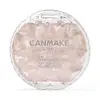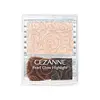What's inside
What's inside
 Key Ingredients
Key Ingredients

 Benefits
Benefits

 Concerns
Concerns

 Ingredients Side-by-side
Ingredients Side-by-side

Triethylhexanoin
MaskingSynthetic Fluorphlogopite
Dimethicone
EmollientDiisostearyl Malate
EmollientDimethicone/Vinyl Dimethicone Crosspolymer
Skin ConditioningSilica
AbrasiveSqualane
EmollientOlea Europaea Fruit Oil
MaskingCeramide NP
Skin ConditioningSimmondsia Chinensis Seed Oil
EmollientRosa Canina Fruit Oil
EmollientRetinyl Palmitate
Skin ConditioningCentella Asiatica Leaf Extract
Skin ConditioningButylene Glycol
HumectantMicrocrystalline Wax
Emulsion StabilisingParaffin
PerfumingTocopherol
AntioxidantPhenoxyethanol
PreservativeMethylparaben
PreservativeAscorbyl Dipalmitate
AntioxidantTitanium Dioxide
Cosmetic ColorantIron Oxides
Aluminum Hydroxide
EmollientTin Oxide
AbrasiveTriethylhexanoin, Synthetic Fluorphlogopite, Dimethicone, Diisostearyl Malate, Dimethicone/Vinyl Dimethicone Crosspolymer, Silica, Squalane, Olea Europaea Fruit Oil, Ceramide NP, Simmondsia Chinensis Seed Oil, Rosa Canina Fruit Oil, Retinyl Palmitate, Centella Asiatica Leaf Extract, Butylene Glycol, Microcrystalline Wax, Paraffin, Tocopherol, Phenoxyethanol, Methylparaben, Ascorbyl Dipalmitate, Titanium Dioxide, Iron Oxides, Aluminum Hydroxide, Tin Oxide
Polyglyceryl-2 Triisostearate
EmulsifyingTriethylhexanoin
MaskingMagnesium/Potassium/Silicon/Fluoride/Hydroxide/Oxide
Stearic Acid
CleansingZinc Myristate
Hdi/Trimethylol Hexyllactone Crosspolymer
Pentylene Glycol
Skin ConditioningBis-Diglyceryl Polyacyladipate-2
EmollientPhenoxyethanol
PreservativeHydrogen Dimethicone
Methylparaben
PreservativeSilica
AbrasiveTocopherol
AntioxidantButylene Glycol
HumectantWater
Skin ConditioningSodium Hyaluronate
HumectantAnthemis Nobilis Flower Extract
MaskingLavandula Angustifolia Flower Extract
CleansingRosmarinus Officinalis Leaf Extract
AntimicrobialTalc
AbrasiveMica
Cosmetic ColorantTitanium Dioxide
Cosmetic ColorantCI 77492
Cosmetic ColorantTin Oxide
AbrasiveAluminum Hydroxide
EmollientPolyglyceryl-2 Triisostearate, Triethylhexanoin, Magnesium/Potassium/Silicon/Fluoride/Hydroxide/Oxide, Stearic Acid, Zinc Myristate, Hdi/Trimethylol Hexyllactone Crosspolymer, Pentylene Glycol, Bis-Diglyceryl Polyacyladipate-2, Phenoxyethanol, Hydrogen Dimethicone, Methylparaben, Silica, Tocopherol, Butylene Glycol, Water, Sodium Hyaluronate, Anthemis Nobilis Flower Extract, Lavandula Angustifolia Flower Extract, Rosmarinus Officinalis Leaf Extract, Talc, Mica, Titanium Dioxide, CI 77492, Tin Oxide, Aluminum Hydroxide
Alternatives
Ingredients Explained
These ingredients are found in both products.
Ingredients higher up in an ingredient list are typically present in a larger amount.
Aluminum Hydroxide is a form of aluminum. It can be naturally found in nature as the mineral gibbsite. In cosmetics, Aluminum Hydroxide is used as a colorant, pH adjuster, and absorbent.
As a colorant, Aluminum Hydroxide may add opacity, or reduce the transparency. Aluminum hydroxide is contains both basic and acidic properties.
According to manufacturers, this ingredient is an emollient and humectant. This means it helps hydrate the skin.
In medicine, this ingredient is used to help relieve heartburn and help heal ulcers.
There is currently no credible scientific evidence linking aluminum hydroxide in cosmetics to increased cancer risk.
Major health organizations allow the use of aluminum hydroxide in personal care products and have not flagged it as a carcinogenic risk at typical usage levels.
Learn more about Aluminum HydroxideButylene Glycol (or BG) is used within cosmetic products for a few different reasons:
Overall, Butylene Glycol is a safe and well-rounded ingredient that works well with other ingredients.
Though this ingredient works well with most skin types, some people with sensitive skin may experience a reaction such as allergic rashes, closed comedones, or itchiness.
Learn more about Butylene GlycolMethylparaben is a preservative and is a paraben. It is used to prevent the growth of fungus, mold, and other harmful bacteria. Parabens are chemicals used as preservatives in both cosmetics and food.
Methylparaben can be synthetically created. It can also be found naturally in some fruits, such as blueberries.
Oftentimes, Methylparaben is combined with other parabens to help increase the shelf life.
The safety of Methylparaben is currently being studied. While ongoing studies are looking into the safety of parabens, the results have been very mixed. Some studies have not found Methylparaben to be harmful.
Learn more about MethylparabenPhenoxyethanol is a preservative that has germicide, antimicrobial, and aromatic properties. Studies show that phenoxyethanol can prevent microbial growth. By itself, it has a scent that is similar to that of a rose.
It's often used in formulations along with Caprylyl Glycol to preserve the shelf life of products.
Silica, also known as silicon dioxide, is a naturally occurring mineral. It is used as a fine, spherical, and porous powder in cosmetics.
Though it has exfoliant properties, the function of silica varies depending on the product.
The unique structure of silica enhances the spreadability and adds smoothness, making it a great texture enhancer.
It is also used as an active carrier, emulsifier, and mattifier due to its ability to absorb excess oil.
In some products, tiny microneedles called spicules are made from silica or hydrolyzed sponge. When you rub them in, they lightly polish away dead skin layers and enhance the penetration of active ingredients.
Learn more about SilicaTin Oxide is an inorganic oxide used to add opacity and volume to a product. In nature, it is already found in mineral form. The main ore of tin is an opaque and shiny mineral called casseterite.
Tin Oxide helps remove translucency in a product, or make it more opaque. Besides adding opacity, tin oxide is used for bulking to add volume.
Titanium dioxide is a mineral UV filter widely used in sunscreens and cosmetics.
It is one of only two UV filters officially classified as “mineral” by regulatory agencies, the other being zinc oxide.
Titanium dioxide provides broad-spectrum protection mostly in the UVB and UVAII range, with some protection in the UVAI range.
While its UVA protection isn’t as strong as zinc oxide’s, the difference is minor.
A common myth is that mineral UV filters reflect UV light. However, modern research shows titanium dioxide absorbs UV radiation like chemical filters (~95% absorption & 5% reflection).
Thanks to its non-irritating nature, titanium dioxide is suitable for sensitive, acne-prone, or redness-prone skin. It is unlikely to cause "eye sting" like other sunscreen ingredients.
A major drawback of this ingredient is its white cast and thick texture. This is why mineral sunscreens often leave a white cast and are less cosmetically elegant than chemical/hybrid sunscreens.
To improve white cast and spreadability, micronized or nano-sized titanium dioxide is often used.
There are ongoing concerns surrounding nano-titanium oxide's impact on marine ecosystems.
There is no conclusive evidence that any form of titanium oxide (or any other sunscreen ingredients) will cause harm to marine ecosystems or coral reefs. The science is still developing but many consumers are keeping a close eye on this issue.
Please note, many destinations have reef-safety sunscreen rules. For instance, the U.S. Virgin Islands advises all visitors to use non-nano mineral sunscreens.
Nano mineral sunscreens once raised safety concerns about absorption into skin.
Extensive research has shown that they do not penetrate healthy or damaged skin; they remain safely on the surface and the top layer of dead skin (stratum corneum).
You'll likely find titanium dioxide bundled with alumina, silica, or dimethicone. These ingredients help make titanium dioxide highly photostable; this prevents it from interacting with other formula components under UV light.
Learn more about Titanium DioxideTocopherol (also known as Vitamin E) is a common antioxidant used to help protect the skin from free-radicals and strengthen the skin barrier. It's also fat soluble - this means our skin is great at absorbing it.
Vitamin E also helps keep your natural skin lipids healthy. Your lipid skin barrier naturally consists of lipids, ceramides, and fatty acids. Vitamin E offers extra protection for your skin’s lipid barrier, keeping your skin healthy and nourished.
Another benefit is a bit of UV protection. Vitamin E helps reduce the damage caused by UVB rays. (It should not replace your sunscreen). Combining it with Vitamin C can decrease sunburned cells and hyperpigmentation after UV exposure.
You might have noticed Vitamin E + C often paired together. This is because it is great at stabilizing Vitamin C. Using the two together helps increase the effectiveness of both ingredients.
There are often claims that Vitamin E can reduce/prevent scarring, but these claims haven't been confirmed by scientific research.
Learn more about TocopherolTriethylhexanoin is created from glycerin and 2-ethylhexanoic acid. It is a solvent and emollient.
As a solvent, Triethylhexanoin helps dissolve ingredients to stable bases or help evenly distribute ingredients throughout the product.
It is also an emollient and helps condition the skin.
Learn more about Triethylhexanoin